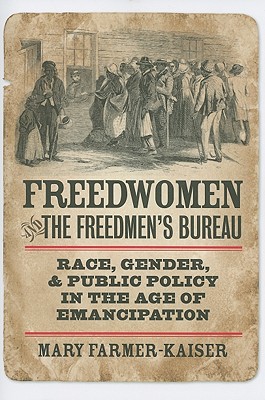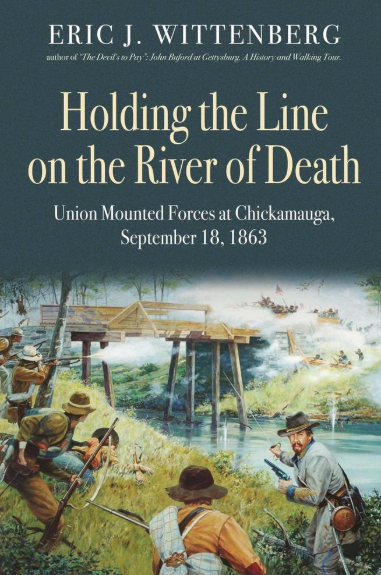Freedwomen and the Freedmen’s Bureau: Race, Gender, and Public Policy in the Age of Emancipation by Mary Farmer-Kaiser. Fordham University Press, 2010. Cloth, ISBN: 0823232115. $80.00.
 “If women-whippers and negro shooters go unpunished in this section of the United States, it will be many years before the removal of the curse of military rule as it is termed by the people hereabouts” (79). This unheeded threat tersely written by Georgia bureau agent O. H. Howard in 1867 reminds us of the unrealized promises and incomplete restitution made to America’s former slaves as well as the complicated relationships among persons of differing class, gender, race, and birthplace. Scholars of the Bureau of Refugees, Freedmen, and Abandoned Lands (hereafter the Freedmen’s Bureau or bureau) have long established the futility of this grossly under-funded, unwelcomed, and culturally naive federal body. But rather than lament the short life span of this well-intentioned agency, Mary Farmer-Kaiser’s study, Freedwomen and the Freedmen’s Bureau: Race, Gender, and Public Policy in the Age of Emancipation, analyzes interactions between bureau agents and freedpersons, and local authorities in order to examine freedwomen’s active role in shaping both public policy and definitions of womanhood, manhood, and race.
“If women-whippers and negro shooters go unpunished in this section of the United States, it will be many years before the removal of the curse of military rule as it is termed by the people hereabouts” (79). This unheeded threat tersely written by Georgia bureau agent O. H. Howard in 1867 reminds us of the unrealized promises and incomplete restitution made to America’s former slaves as well as the complicated relationships among persons of differing class, gender, race, and birthplace. Scholars of the Bureau of Refugees, Freedmen, and Abandoned Lands (hereafter the Freedmen’s Bureau or bureau) have long established the futility of this grossly under-funded, unwelcomed, and culturally naive federal body. But rather than lament the short life span of this well-intentioned agency, Mary Farmer-Kaiser’s study, Freedwomen and the Freedmen’s Bureau: Race, Gender, and Public Policy in the Age of Emancipation, analyzes interactions between bureau agents and freedpersons, and local authorities in order to examine freedwomen’s active role in shaping both public policy and definitions of womanhood, manhood, and race.
Farmer-Kaiser focused her research on bureau records from Virginia, Georgia, Louisiana, and Texas. She also incorporated researchers’ work pertaining to the rest of the South. She argues that bureau agents—who were primarily middle-class, white, Union veterans—imported their mid-nineteenth-century northern ideologies of patriarchy, their fixation on the contract, and their ideal of the dependent domestic woman in an attempt to inculcate a free labor ethos in the postemanancipation South. Methodologically, she allies herself with Laura Edwards by building upon the latter’s scholarship on the localized legal culture of the South. She develops this framework in her first chapter by explaining the structure of the bureau, the intentions and make-up of its staff, and its ideologies and policies. She then presents her evidence of how gender affected decisions made by local bureau agents by providing documented examples. The reader follows the interaction between bureau agent and freedwoman as they describe the issue at state in, mostly, their own words. Whereas prior scholars claimed that the bureau dealt principally with freedmen rather than freedwomen, Farmer-Kaiser convincingly demonstrates the agency with which former slave women entered these federal offices to speak for themselves and their families.
Farmer-Kaiser categorizes the interactions between bureau agents and divides them into her four chapters on local agents’ distribution of federal material relief, the attempted implementation of a free labor system void of vagrancy, intervention in defining parental rights and the apprenticeship system, and the futile attempts made by the bureau to secure equal justice for freedpersons. She triangulates her findings with diaries, oral histories, autobiographies, manuscript collections, congressional testimony, and bureau records. Her complementary utilization of oral history and archives lends agency and a voice to the freedwomen who approached the bureau. Through the interactions therein, Farmer-Kaiser exposes the seemingly contradictory ways in which bureau agents applied policy toward freedwomen versus freedmen. Where the federal policies of the Freedman’s Bureau made no mention of gender, the local reality evidenced gendered discrepancies in agents’ decisions.
However, when considering the monograph as a whole, the reader encounters some repetition. It seems as though Farmer-Kaiser’s categories, though helpful in developing an approachable thematic organization, are not so distinct. A particular point of overlap occurs in her examination of the apprenticeship system, which she compellingly describes as “a ‘compulsory’ system of ‘free’ labor” (81). The practice of apprenticing freedchildren to their previous masters or other white employers involves issues of parental rights, contradictions within the free labor system’s implementation, as well as the need to secure equal justice, since the practice was not equally applied to impoverished white children.
Farmer-Kaiser’s contribution adds to our understanding of where conflicting philosophies in terms of class, geography, race, and gender collided in the Reconstruction-era South. She recognizes the complicated and sometimes contradictory definitions from which these historical actors worked. Consequently, her expanded framework more comprehensively accounts for the Bureau’s actions and policy than previous dualist analyses. Her argument follows the field’s historiographical trend to question the alleged barriers between the so-called private and public spheres. The domestic and the political are clearly tightly coupled when a freedwoman who was a single mother demanded the return of her apprenticed daughter: “She’s my little gal, an’ I has a right to hev her, an’ I wants her” (112). These breakdowns between the private and the public tend to occur when different stakeholders hold contradictory perceptions of the definition of labor, gender, and race. By illustrating the Freedmen Bureau’s role in shaping these definitions, Farmer-Kaiser joins a host of scholars who have advanced a more nuanced view of freedpeople’s collective journey through “what the historian Nancy Bercaw calls ‘a bizarre web of contradictory gender, racial, and class ideologies’” on their way to American citizenship (8).
Carolyn Chesarino is an M.S. Candidate in Library Science at the University of North Carolina, Chapel Hill.
